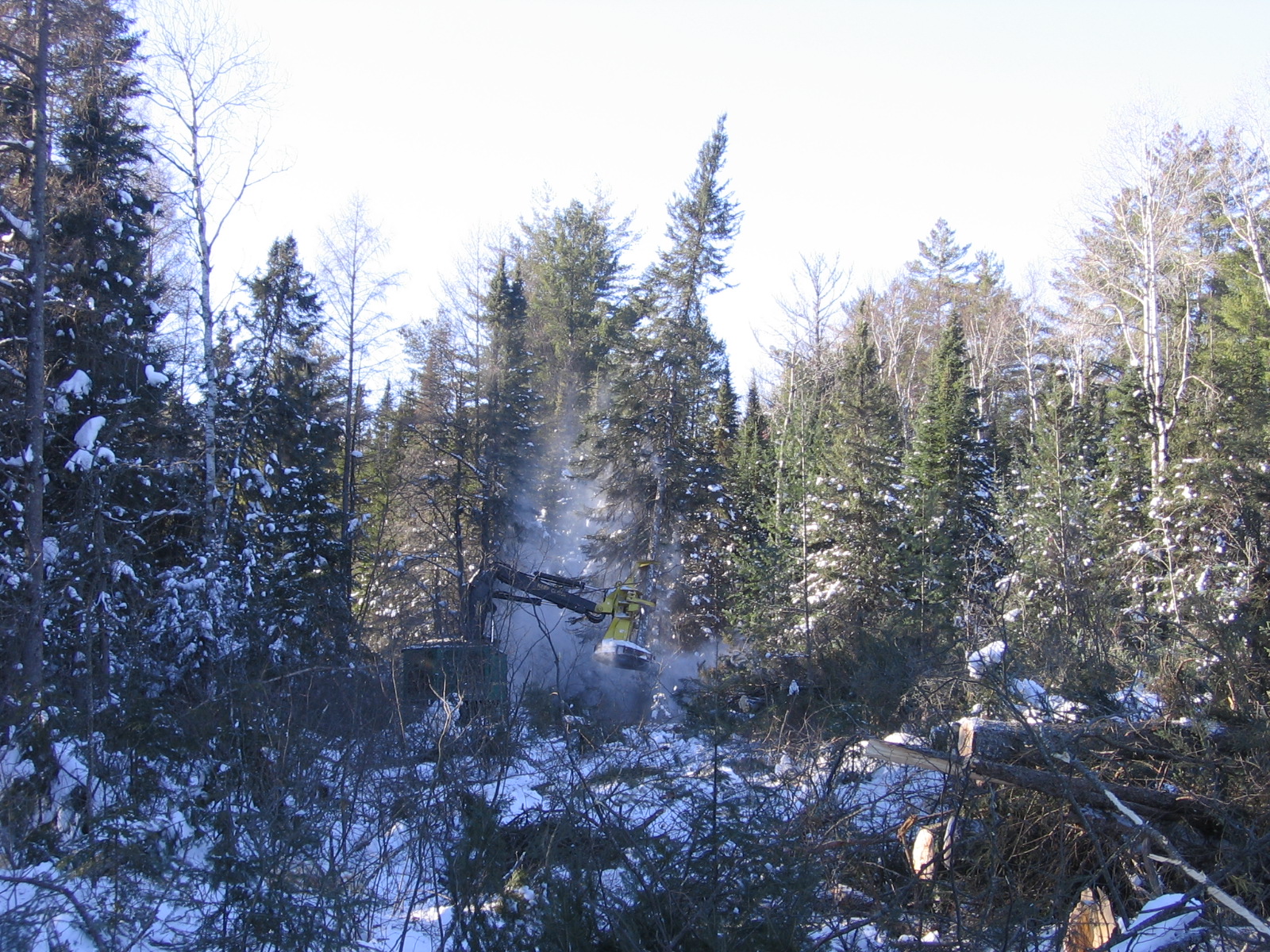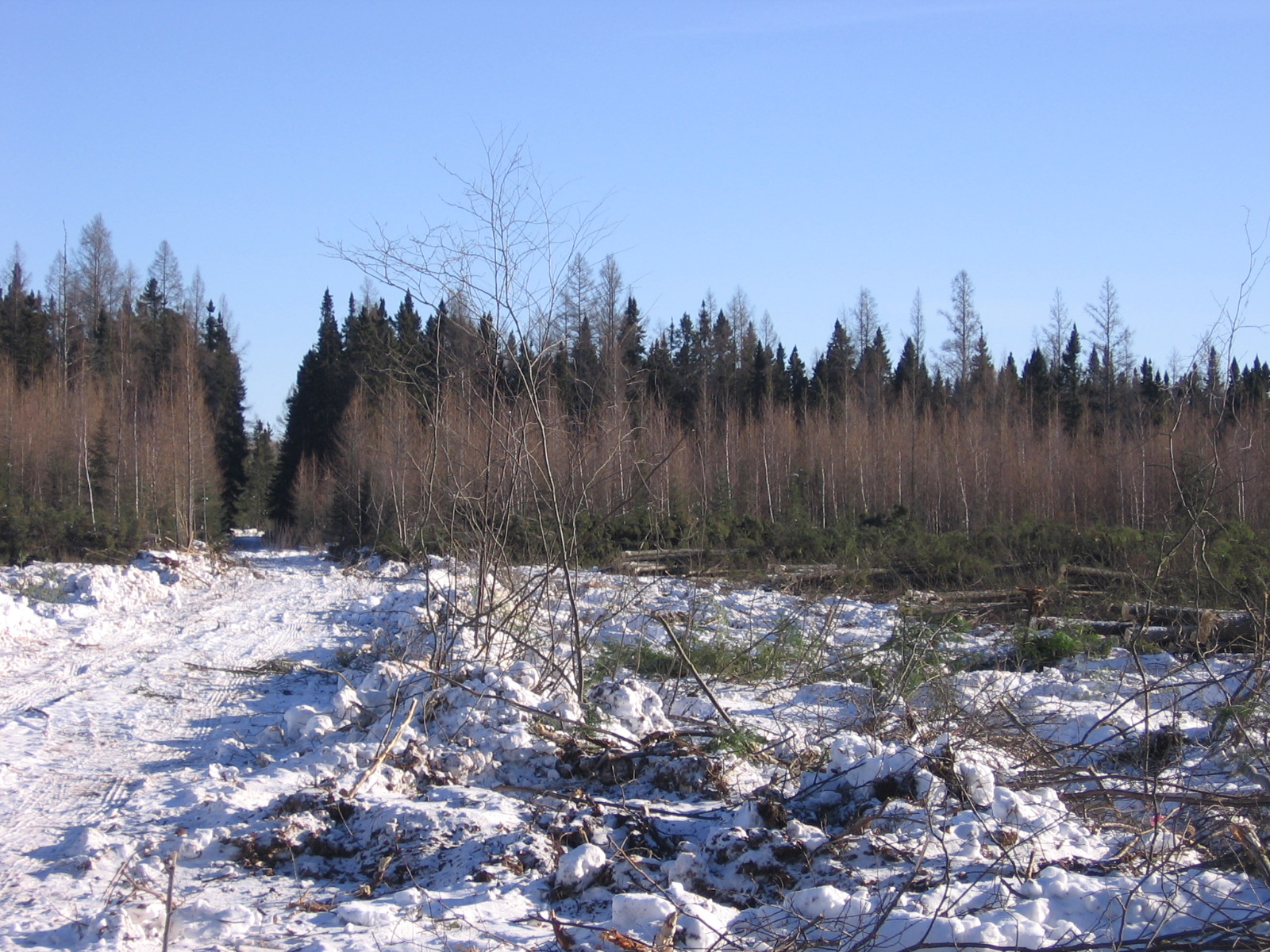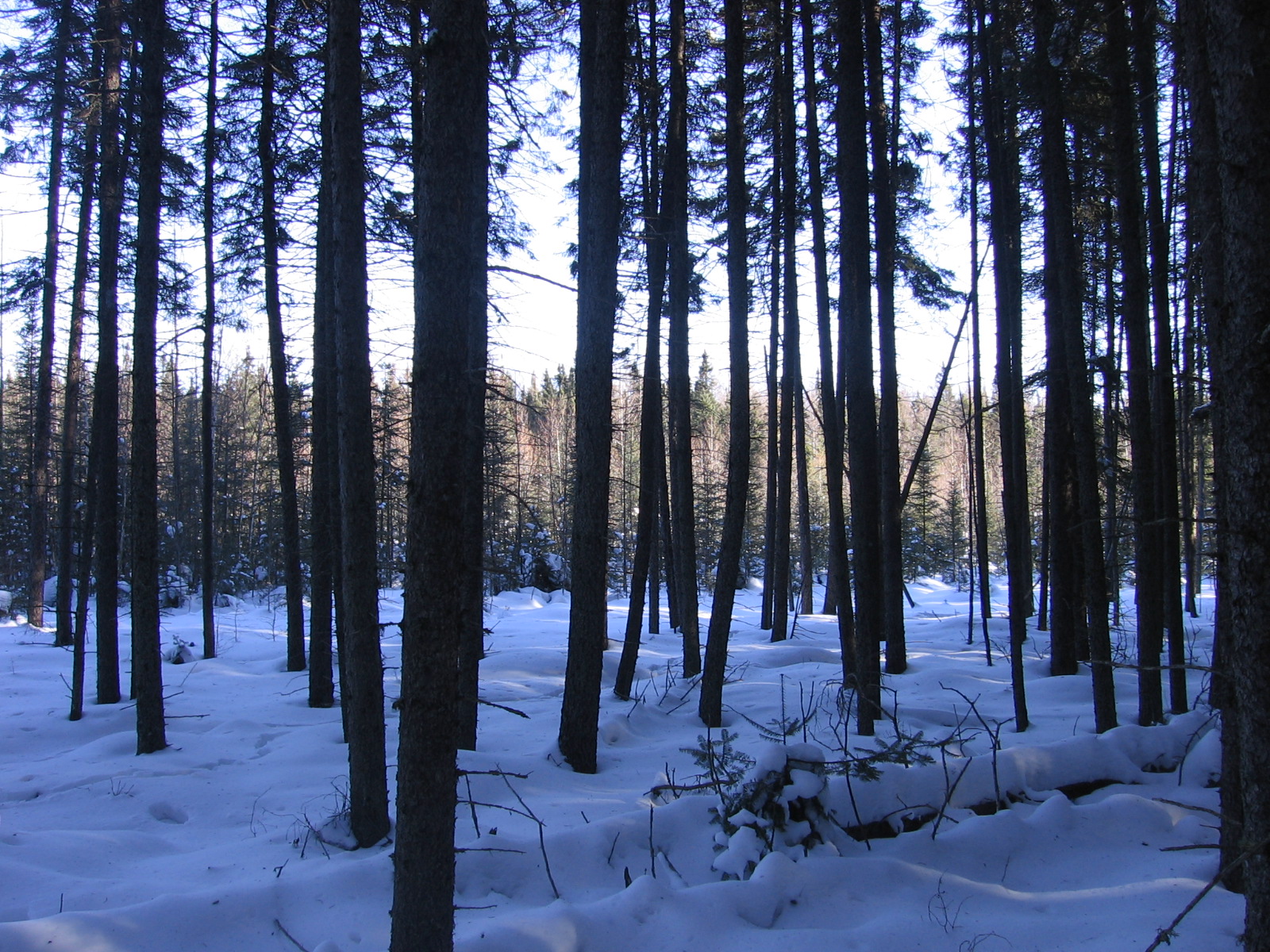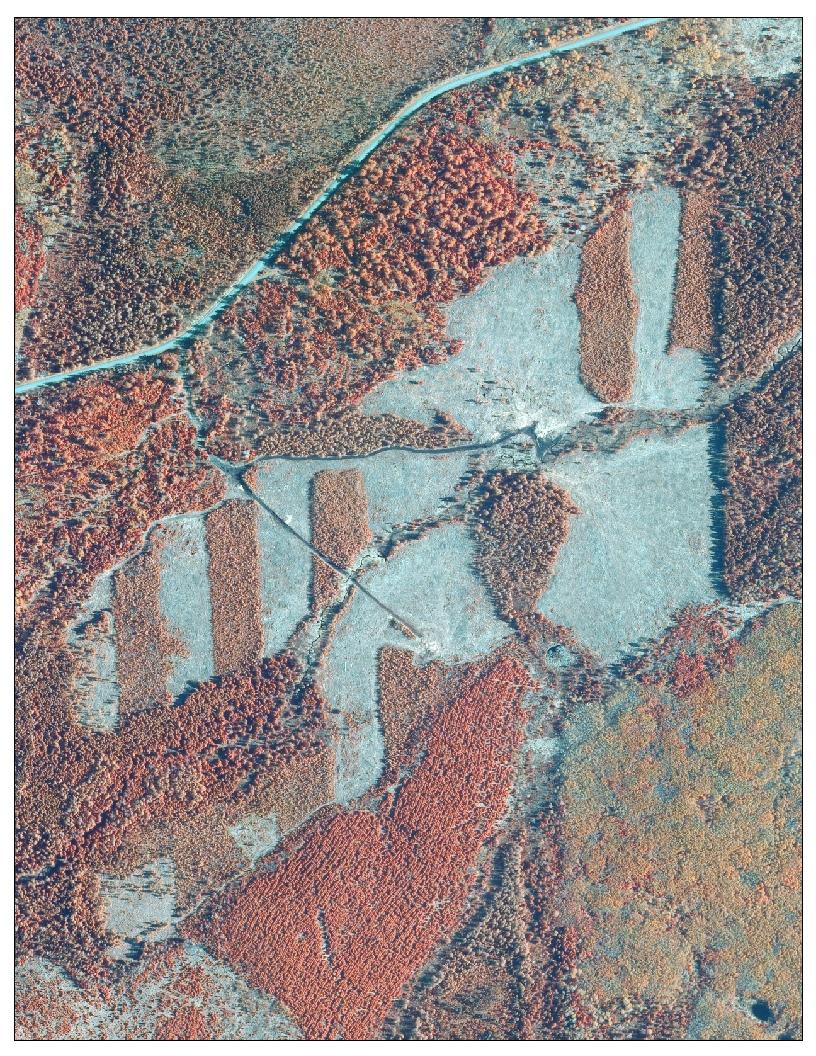Overview
A two entry harvest consisting of cut strips in a 120 year old plus Black spruce/Tamarack type. Designed to allow for natural seeding of the initial cut strips by the initial leave strips, which were subsequently harvested 20 years later.
First entry…. K-B Spruce 1, 33 acres
Second entry…. K-B Spruce 2, 82 acres
Silviculture Objective(s)
The objective was to take advantage of Black spruce capacity for natural seeding, by allowing leave areas from first entry harvest to fully seed and regenerate the initial cut strips. When it was determined that we had successfully regenerated these areas to Black spruce and Tamarack, we would follow-up with a second entry to harvest all the initial leave areas. The time period between these entries could be as little as 4-5 years, but due to administrative changes in our department, it ended up being twenty years between these two harvests.
Pre-treatment stand description and condition
Stand establishment and management history:
We have no information on stand establishment history, but can state that the stand had not seen management activity in the modern time period. There may have been some cutting in the stand prior to modern records, but we can’t confirm that. The age of the oldest trees would indicate a lack of management activity.
Pre-treatment species composition:
Basal areas ranged from 110-170 BA, 20-45 cords/acre by plot data (avg. 24 cords/acre)
Pre-treatment growth and stocking:
Stand consisted of Black spruce 76% by volume, Tamarack 24% by volume, with minor volumes of Aspen, Birch and Balsam fir.
Silviculture Prescription
In 1987, the initial 8 cut strips which were each 4 chains (264’) wide, were flagged and painted out. They were oriented north-south to take advantage of prevailing westerly winds. Natural seeding of black spruce can be relied on up to 4 chains from the windward side of a mature stand and up to 2 chains from the leeward side. Thus a strip perpendicular to the prevailing wind direction can be up to 6 chains wide with natural seeding from both sides, or 4 chains wide with seeding only from the windward side.
What actually happened during the treatment
On K-B Spruce 1 the 8 cut strips totaled 33 acres, and all areas had an excellent seed bed for black spruce and tamarack, consisting primarily of sphagnum moss (as opposed to the feather mosses). The cruise for this initial harvest showed 805 cords of black spruce and 80 cords of tamarack. The harvest regulations called for utilizing all trees 4”dbh and larger and 2 sticks or more to a 3” top diameter. All black spruce or tamarack over 5 feet in height were required to be felled, to avoid an uneven-aged subsequent stand. Any cedar within the stand were reserved from cutting due to wildlife (primarily deer) considerations. Landings were established on an adjacent upland area. This first sale was harvested in the winters of 1987-88 and 1988-89, by two different logging companies.
As stated earlier, due to administrative area shake-ups in our department, instead of coming back 4-5 years later to harvest the initial leave strip areas, it wasn’t until 2004 that the second sale, K-B spruce 2, (82.3 aces) was set-up. On this sale, landings were allowed in the harvested type (not an upland setting), and logger was required to full tree harvest, with randomized skidding for maximized cone/seed drop on site. The cruise for this sale showed 1625 cords of black spruce, and 670 cords of tamarack to be harvested, with minor amounts of aspen, birch and balsam. With sale extension, it didn’t actually get harvested until late winter of 2008-09 (20 years after the initial harvest of strips). It was finished just prior to break-up setting in…way too close for comfort, but it turned out fine.
Although we might have done quite well with natural cone/seed drop from the harvest, it was decided to take out an insurance policy on the regeneration of the harvested areas of K-B Spruce 2, and do an aerial seed drop. In the spring of 2009, under the State of MN-DNR seeding contract, we were able to drop 2 ounces/acre of black spruce seed onto the final cut strips/areas.

Figure 1: Feller buncher at work on harvest strip of K-B Spruce 2

Figure 2: Freshly harvested black spruce strip on K-B Spruce 2, with regenerated strip of K-B spruce 1 in near background (heavy to tamarack), and yet unharvested strip of K-B Spruce 2 in distant background.

Figure 3: View from within yet to be harvested strip of K-B Spruce 2, looking out into regenerated strip of K-B Spruce 1.
Post-treatment assessment
A formal survey of the initial cut strips from K-B Spruce 1 was never actually carried out, but we were incredibly satisfied with the regeneration stocking of the site when visually evaluated over the years post-harvest. It is a heavily stocked stand consisting of black spruce, tamarack (tallest and fastest response from this species), with lots of other species present, including a surprising amount of paper birch out in this swamp type.
In the summer of 2014, I asked our summer intern to put in survey plots on the cut strips of K-B Spruce 2, to gauge regeneration response. There were two cutting blocks that took in the 10 separate cutting strips or areas of this sale (north and south of the creek that divides them). In block 1 his survey showed 1500 black spruce per acre and 410 tamarack per acre. In block 2, it was 2650 black spruce per acre, and 325 tamarack per acre. There were also birch, red maple, balsam fir, and even some red pine from surrounding seed source. Needless to say, we are very happy with the level of stocking that has been achieved in all harvest areas of the two sales.
Plans for future treatments
It will be quite a long time before another treatment or harvest is called for or recommended in this stand, perhaps well into the next century. The new stand brought on by these two harvest entries is well stocked and off to a good start. Other than monitoring growth and condition, no treatment should be needed until that time.
Costs and economic considerations
I cannot say that this two entry harvest system is definitively recommended by us. While our regeneration results were very good, there was a substantial amount of extra time and cost involved with setting this up as two sales with cutting strips laid out and additional sale administration costs, etc. An argument could be made for the simplicity and cost savings of just doing a complete clearcut harvest with randomized full tree skidding, and aerial seeding the entire site upon harvest completion. We did see a substantial increase in the sold price of the black spruce and tamarack over the intervening years between the two sales, but this might not have even offset the additional costs incurred. Based on what we saw for regeneration results on the second sale followed by aerial seeding, excellent outcomes can be achieved by this simpler silvicultural approach as well. Still, it was good to experiment with this two entry strip cutting system approach.

